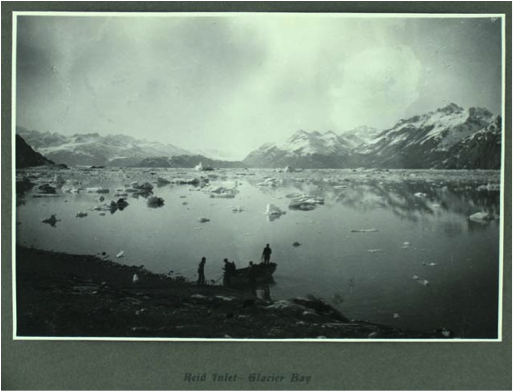The Expedition Documentation Trifecta: Harriman Alaska Expedition (1899)
This is the third in a 4 part joint blog series by the Field Book Project (FBP) and the Biodiversity Heritage Library (BHL), showcasing examples of digital connections between museum specimens, field book catalog records, and the resulting publications.
In 1899 Edward Harriman, President of the Union Pacific Railroad, turned a family vacation into a two month foray into Alaska. Originally proposed as a hunting expedition, it was transformed into a scientific exploring expedition on the advice of Clinton Hart Merriam, Chief of the Bureau of Biological Survey. Harriman and his family, accompanied by 126 researchers, traveled to Alaska aboard the S.S. George W. Elder. In the end, the work of the many researchers resulted in vast amounts of valuable scientific data, including the discovery of a new glacier and an array of floral and faunal specimens.
 |
| Reid Inlet, Glacier Bay 1899. Photographed by Edward S. Curtis. |
Harriman and the Washington Academy of Sciences collaborated to fund the entire expedition, and Harriman chose researchers with diverse scientific backgrounds in order to collaborate on all fields of plant, animal, and earth science. After the expedition had ended, the scientists published a multi-volume Harriman Alaska Series, sometimes simply known as Alaska, of which vols. 6-7 were never published.
The Harriman Expedition is a particular favorite, because among the field documentation at Smithsonian Institution Archives, are two photograph albums of images from during the trip. Many of these images are available to view on Smithsonian Collection Search Center.
For such a large expedition with participants from across the Institution, you would think the field notes would be numerous and comprise their own collection. There are only as few as 6 field books from the Harriman Expedition found across the National Museum of Natural History (NMNH) and Smithsonian Institution Archives (SIA).
The photograph albums mentioned above reside in SIA; field notes of A. K. Fisher are in NMNH, Division of Mammals; T. H. Kearney’s journal is in the Department of Botany’s field book collection housed in the Main NMNH Library. Additionally there is item “Walpole, paintings, 1899 – 1904” whose abstract explains it may contain illustrations from the Harriman Expedition. One would only know this by the abstract or reading the field book content. Additionally these various field notes were cataloged by the Field Book Project, November 2011 – July 2012.
Specimens are equally difficult to track down. Though US National Museum received a collection of mollusks, birds, and plants, many of these specimens do not state they came from the expedition. One must know the collector, location, and/or time period.
Publications resulting from the expedition are a bit easier to locate, given the close relationship between Harriman and the Washington Academy of Sciences. In addition to the Harriman Alaska Expedition series linked above, the Biodiversity Heritage Library provides the following publications:
|
Whether an expedition is large or small, its resulting natural history documentation can lose its connections and become increasingly difficult to locate. Cataloging and digitization efforts by Smithsonian and consortiums like the Biodiversity Heritage Library offer researchers increasingly better odds of rediscovering those connections. Stay tuned for the fourth and final blog post in the series.





Leave a Comment